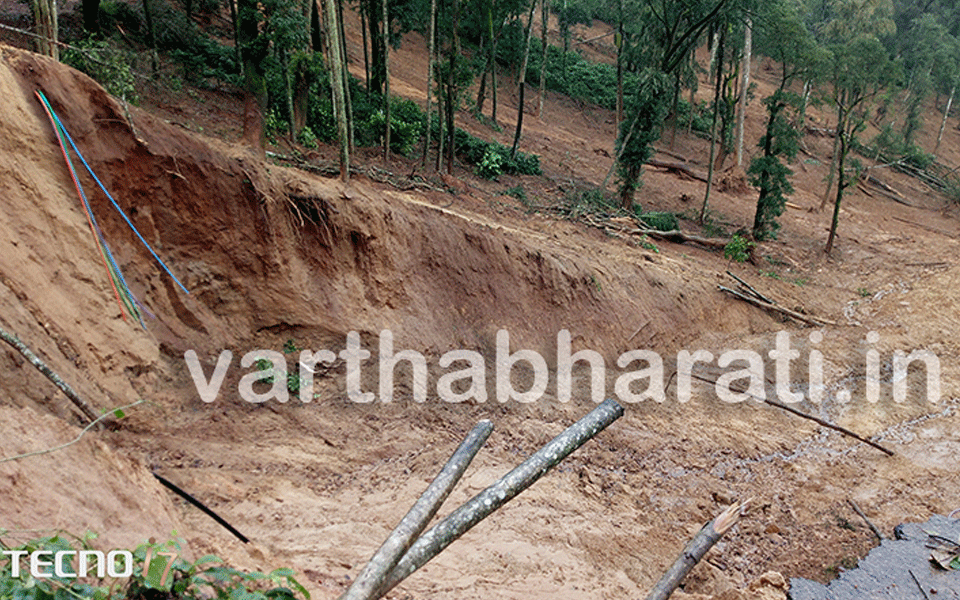►Elders and leaders of organisations warn
# Washed out Kodagu: A series of special reports
Madikeri, August 26: Kodagu is a district covered with hills and valleys. Conservation of these hills is a must to save Kodagu district. It is impossible to imagine Kodagu without hills and valleys. Instead of natural disaster, manmade disasters are the main reason for the present situation of Kodagu district.
There is a big difference between Kodagu two decades ago and the present scenario. Concrete buildings come up in Kodagu which was covered with thick forest, high rise trees and greenery. Tar and concrete roads were laid amidst the forest area. Rubber plantations are being grown by cutting the natural forest. Increased ginger cultivation has depleted the fertility of the soil. Since it is tourist hotspot, the number of hotels and homestays is increasing considerably nowadays. Because of the greed of human beings, the nature is being exploited. This unimagined exploitation of nature has caused such a widespread destruction, according to experts.
Those who come to see the natural disaster at Makkandur in Madikeri taluk expressed their opinions with ‘Varthabharati’.
Kodagu district is a nature’s bounty with beautiful waterfalls and hill ranges. Most parts of the district covered with thick forest and greenery. It’s land of natural resources. More importantly, it is the birthplace of Karnataka’s lifeline Cauvery River. More than this, it is one of the bio-diversity hotspots with rare species of flora and fauna. But they are at the verge of extinct. The worst ever natural disasters are happening now. What’s the use if the people worried now, asks retired army officer KP Jagadeesh.
Deforestation was in large scale to grow rubber and coffee. The hill range was damaged to plant rubber saplings. As the hills are digging like steps to plant rubber plants, the surface of the hills was completely damaged due to which the rainwater is easily percolating instead of flowing down. As a result, the soil is loosening, and big hills are collapsing causing widespread devastation. Thousands of people are on the streets now. We should blame ourselves for this disaster instead of pointing towards the nature, said Kodagu Unification Committee president Suguna Muttanna.
In order to construct concrete buildings atop the hills, roads are being laid around the hills by digging the foot of the hills due to which, the hills are losing their base and balance. The place where the rainwater is flowing is being flattened for constructing buildings and roads. The natural flow of rivers and streams are being diverted. When its raining heavily, the rainwater flows over the roads and gushes into the houses in the absence of natural ways to flow. This would cause landslides and this is man-made disaster, he said.
One cannot deny the negligence of the district administration and the government for this situation. Both the authorities have failed to protect and conserve the rainforests, natural resources and Kodagu. Though there are some policies are in place to protect the environment, they are not being followed strictly. So, Kodagu will require a separate policy. First the authorities should check digging of hill bases, deforestation and timber mafia. Otherwise, Kodagu people have to face more disasters than this one, said Lions former president JS Madappa.
Permission should not be given to dig hills. If it is necessary, then the district administration should see to it that the norms are followed strictly. While laying roads around hills, proper drainage facility should be made to let rain water and construct retention walls. In place of streams and valleys, alternative arrangements should be made to lay roads. For any reasons, the natural flow of streams should not be diverted. Ginger is being grown in large scale. As the soil fertility is decreasing due to ginger crops and this is also causing damages. The district administration should take steps about this, Madappa said.
A couple of days before the landslides that happened in many places across the district, the cracks were developed in some places. Many people have observed these cracks in their plantations. They have observed the cracks on roads where the hills were sunk and informed the district administration through local bodies. But the district administration has failed to act on it, alleged a villager.
Landslides might have happened in hill ranges and non-inhabited places. This might have happened due to shifting of land’s base. The rainwater percolated in those cracks causing landslides. If the district administration took steps to shift the people and precautionary measures as soon as it was informed, more disaster could have been avoided, Kodagu District Growers Federation president Harish Appaiah said.


Let the Truth be known. If you read VB and like VB, please be a VB Supporter and Help us deliver the Truth to one and all.
Jaisalmer (PTI): Pushing for a "unified judicial policy", Chief Justice of India Surya Kant on Saturday said technology can help align standards and practices across courts, creating a "seamless experience" for citizens, regardless of their location.
He said high courts -- due to the federal structure -- have had their own practices and technological capacities, and "regional barriers" can be broken down with technology to create a more unified judicial ecosystem.
Delivering the keynote address at the West Zone Regional Conference in Jaisalmer, Kant proposed the idea of a "national judicial ecosystem" and called for an overhaul of India's judicial system with the integration of technology.
"Today, as technology reduces geographical barriers and enables convergence, it invites us to think of justice not as regional systems operating in parallel, but as one national ecosystem with shared standards, seamless interfaces, and coordinated goals," he said.
He emphasised how the role of technology in the judiciary has evolved over time.
"Technology is no longer merely an administrative convenience. It has evolved into a constitutional instrument that strengthens equality before the law, expands access to justice, and enhances institutional efficiency," he said, highlighting how digital tools can bridge gaps in the judicial system.
Kant pointed out that technology enables the judiciary to overcome the limitations of physical distance and bureaucratic hurdles.
"It allows the judiciary to transcend physical barriers and bureaucratic rigidities to deliver outcomes that are timely, transparent and principled," he said, adding that the effective use of technology can modernise the delivery of justice and make it more accessible to citizens across the country.
The CJI called for implementing a "unified judicial policy".
He said India's judicial system has long been shaped by its federal structure, and different high courts have their own practices and technological capacities.
"India's vast diversity has led to different high courts evolving their own practices, administrative priorities and technological capacities. This variation, though natural in a federal democracy, has resulted in uneven experiences for litigants across the country," he said.
Kant underscored that predictability is crucial for building trust in the judicial system.
"A core expectation citizens place upon the courts is predictability," he said, adding that citizens should not only expect fair treatment but also consistency in how cases are handled across the country.
He pointed to the potential of technology in improving predictability.
"Technology enables us to track systemic delays and make problems visible rather than concealed," he said.
By identifying areas where delays occur, such as in bail matters or cases involving certain types of disputes, courts can take targeted action to address these issues and improve efficiency, Kant said.
The CJI explained that data-driven tools could identify the reasons behind delays or bottlenecks, allowing for faster, more focused solutions.
"Technology enables prioritisation by flagging sensitive case categories, monitoring pendency in real time and ensuring transparent listing protocols," he said.
Justice Surya Kant also discussed the importance of prioritising urgent cases where delays could result in significant harm. He highlighted his recent administrative order that ensures urgent cases, such as bail petitions or habeas corpus cases, are listed within two days of curing defects.
"Where delay causes deep harm, the system must respond with urgency," he stated, explaining that technology can help courts identify and expedite such cases.
Kant also raised the issue of the clarity of judicial decisions.
He noted that many litigants, despite winning cases, often struggle to understand the terms of their judgment due to complex legal language.
"Although the orders had gone in their favour, they remained unsure of what relief they had actually secured because the language was too technical, vague or evasive to understand," he said.
He advocated for more uniformity in how judgments are written.
"A unified judicial approach must therefore extend to how we communicate outcomes," he said.
The CJI also discussed the role of AI and digital tools in improving case management. He pointed to the potential of AI-based research assistants and digital case management systems to streamline judicial processes.
"Emerging technological tools are now capable of performing once-unthinkable functions. They can highlight missing precedent references, cluster similar legal questions, and simplify factual narration," he said, explaining how these technologies can help judges make more consistent decisions.
He also highlighted tools like the National Judicial Data Grid and e-courts, which are already helping to standardise processes like case filings and tracking.
Kant reiterated that the integration of technology into the judicial process is not just about improving efficiency but about upholding the integrity of the system and strengthening public trust.
"The measure of innovation is not the complexity of the software we deploy, but the simplicity with which a citizen understands the outcome of their case and believes that justice has been served," he said.





